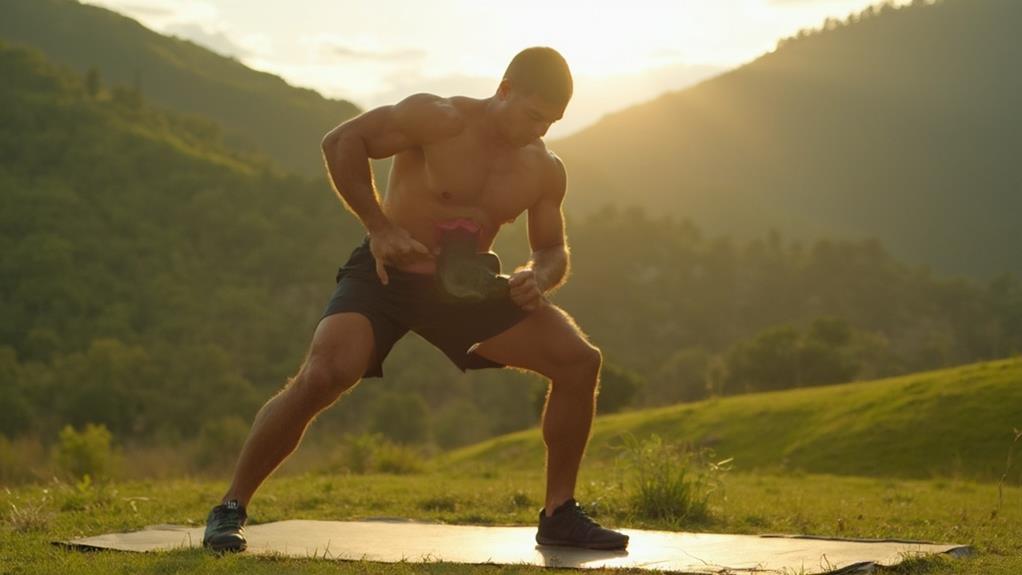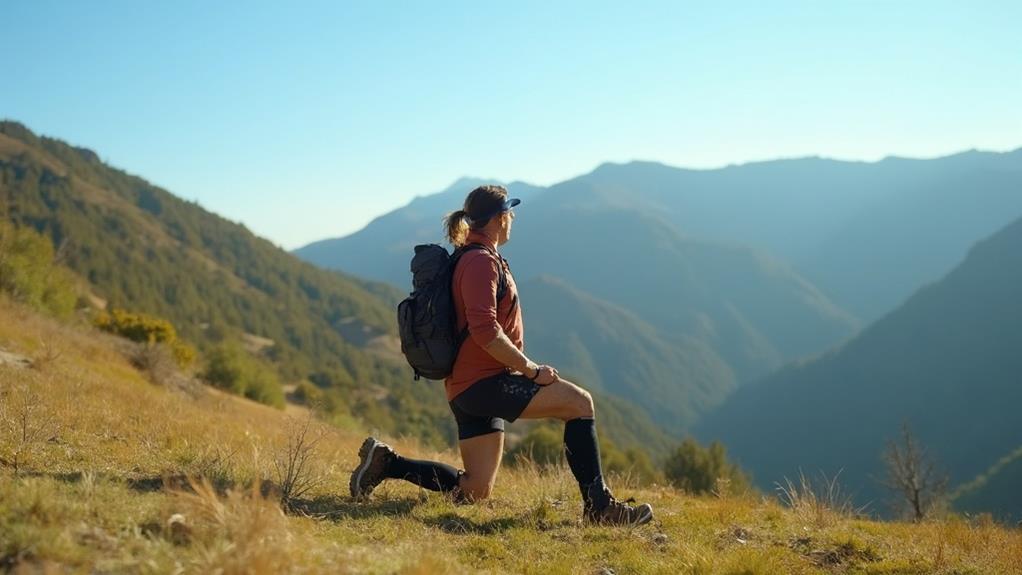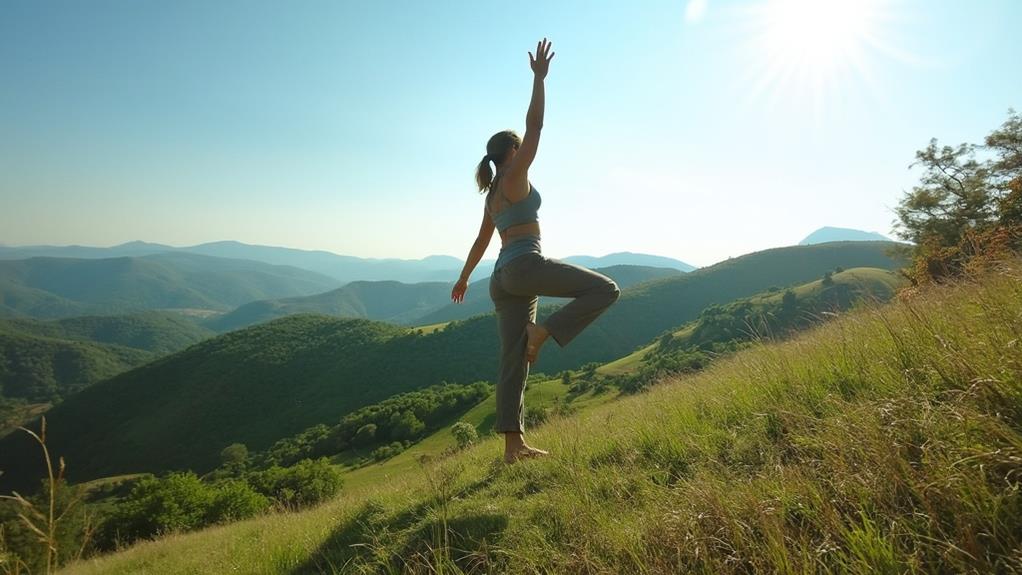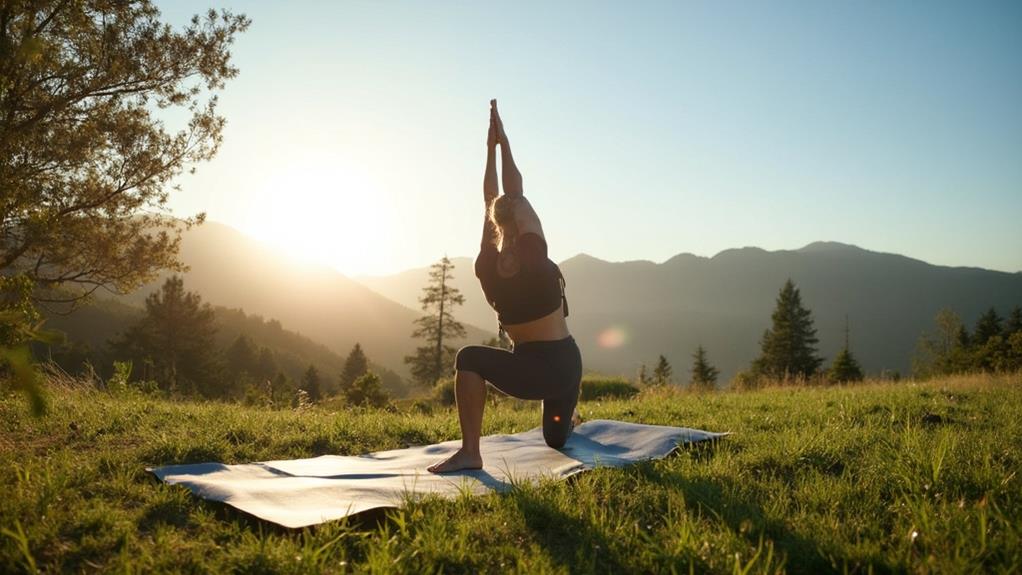Building strength for fell walking involves exercises targeting the lower body, core, and balance. Goblet squats focus on muscle hypertrophy in the glutes and quadriceps, enhancing uphill mobility. Step-ups and downhill lunges strengthen the quadriceps and glutes for improved trail stability. Hanging knee raises and plank holds build core stability, essential for sustained trekking. Calf raises fortify ankle stabilizers, reducing strain risks. Single-leg balances develop proprioception, vital for uneven terrains. Bridge lifts enhance posterior chain strength, and wall sits boost muscular endurance. Each exercise is tailored to improve the efficiency and safety of fell walking through progressive adaptation. Explore further for extensive benefits.
Key Takeaways
- Goblet squats enhance lower body strength and stability, crucial for hiking on uneven terrains.
- Step-ups improve balance and strength, reducing fall risks on trails.
- Downhill lunges develop control and adaptability for steep descents.
- Plank holds engage core muscles, boosting balance and reducing back injury risk.
- Single-leg balances enhance proprioception and stability for traversing uneven terrains.
Goblet Squats
In the domain of strength training, goblet squats stand as a cornerstone exercise, particularly for individuals engaging in fell walking. These squats primarily target the glutes, hamstrings, and quadriceps, vital for building the lower body strength required to traverse uneven terrains.
The proper execution of this exercise involves holding a kettlebell close to the chest, guaranteeing ideal kettlebell positioning, which stabilizes the core and promotes balance. As one descends into the squat, feet should be shoulder-width apart, and the thighs must align parallel to the ground, maintaining a straight back to prevent injury.
Goblet squat variations can be tailored to individual fitness levels and objectives. Beginners might start with a manageable weight, performing 8-15 repetitions to guarantee proper form and gradual strength development. As proficiency increases, weights should be incrementally augmented to continue challenging the muscle groups involved.
This progressive overload is essential for maximizing muscle hypertrophy and endurance, directly benefiting fell walking endeavors.
Incorporating goblet squats into a bi-weekly training regimen enhances lower body strength and core engagement, bolstering stability and balance. This regimen not only improves hiking performance but also mitigates injury risks by fortifying critical muscle groups.
Step-Ups

Step-ups are a highly effective exercise targeting the quadriceps, hamstrings, and gluteal muscles, essential for traversing the steep inclines encountered in fell walking.
The technique involves using a stable platform of 10-16 inches, stepping up with one foot while driving through the heel to maximize glute activation, and ensuring full hip extension for balanced muscular engagement.
For beginners, a regimen of 10 repetitions per leg is recommended, with gradual progression in set volume and step height.
The addition of weights such as a backpack or dumbbells can greatly augment strength and endurance adaptations.
Benefits of Step-Ups
For individuals engaging in fell walking, step-ups serve as a foundational exercise that significantly enhances the muscular strength required for this activity. This exercise is essential for strength development, primarily targeting the quadriceps, hamstrings, and gluteal muscles. Such targeted muscle engagement is fundamental for functional fitness, as these muscle groups play an important role in ascending hills and traversing uneven terrain.
The movement pattern of step-ups closely mimics the biomechanical action of climbing, thereby enhancing the functional strength and endurance necessary for uphill walking.
Beyond muscle strengthening, step-ups offer significant advantages regarding adaptability and progression. By varying the height of the step, individuals can apply the principle of progressive overload, which is crucial for continued strength gains. Beginners may commence with a 10-16 inch platform, while advanced practitioners can increase the height to intensify the challenge.
Introducing weights can further augment muscular endurance, enabling fell walkers to carry heavier loads with increased ease.
Regular implementation of step-ups is also associated with improved balance and stability. This enhancement is essential for reducing the risk of falls, particularly on challenging trails, thereby contributing to overall safety and efficiency in fell walking.
Proper Step-Up Technique
Understanding the proper technique for executing step-ups is vital for maximizing the exercise's benefits and minimizing injury risk. Step-ups effectively target the quadriceps, hamstrings, and gluteal muscles, important for the demanding task of uphill climbing in fell walking.
A significant aspect of this exercise is correct foot placement. Begin with feet hip-width apart, guaranteeing stability and ideal muscle engagement. Position one foot firmly on a 10-16 inch high box or step, making sure the entire foot is secure on the surface to maintain balance control throughout the movement.
As you ascend, focus on driving through the heel of the raised foot, which activates the posterior chain and supports joint safety. Achieve full hip extension at the apex of the movement, maintaining a steady and controlled posture. This guarantees effective muscle activation and reduces the risk of injury.
Upon descent, use the same leg, lowering in a controlled manner to maintain balance and control. Alternate legs with each repetition to achieve balanced muscular development.
To progressively challenge the body, increase the step height or incorporate additional weights as strength improves. Aim for 10-15 repetitions per leg, guaranteeing a thorough strength-building regimen.
Downhill Lunges
Among the numerous exercises beneficial for fell walking, downhill lunges stand out as particularly effective for targeting the quadriceps, glutes, and stabilizer muscles. These muscles are integral for managing the dynamic control required during steep descents, making downhill lunges a essential component of any fell walking training regimen. Incorporating downhill lunge variations can facilitate a thorough workout that addresses multiple muscle groups simultaneously. Lunge progression techniques, such as increasing distance or adding weights, can further enhance muscle endurance and strength, important for tackling diverse terrains.
To execute a downhill lunge, maintain core engagement and an upright posture. Step forward, lowering your back knee toward the ground while your front knee bends to a precise 90-degree angle. Initiating this exercise with a 15-20 yard distance is advisable, with gradual intensification to 50 yards as proficiency develops. The table below outlines a structured approach to integrating downhill lunges into your routine:
| Parameter | Recommendation |
|---|---|
| Starting Distance | 15-20 yards |
| Progression Distance | Up to 50 yards |
| Sets | 2-3 |
| Repetitions per Leg | 10-12 |
| Focus | Controlled movements |
Implementing downhill lunges improves terrain adaptability, enhances hiking performance, and reduces injury risk, making it an irreplaceable exercise for fell walkers.
Hanging Knee Raises

Hanging knee raises are a vital exercise for enhancing core stability, an essential component for effective and safe fell walking.
By employing a controlled movement technique, individuals can maximize the activation of the abdominal muscles, which not only bolsters core strength but also contributes to improved backpack endurance, critical for long treks.
Consistent execution of this exercise fosters overall stability and endurance, thereby equipping fell walkers with the physical resilience required to navigate challenging terrains.
Core Stability Enhancement
When it comes to developing core stability essential for fell walking, incorporating hanging knee raises into your training regimen can greatly boost your performance. As a fundamental component of core workouts, this exercise focuses primarily on the abdominal muscles, which are important for maintaining balance on uneven terrain. Balance exercises such as hanging knee raises not only enhance core stability but also improve grip strength and hip flexor strength. These attributes are essential for maneuvering steep climbs and descents, guaranteeing safe and effective fell walking.
To execute hanging knee raises, secure a firm overhand grip on a pull-up bar and allow your body to hang freely. Engage your core muscles to lift your knees towards your chest while maintaining a straight back. This form guarantees peak muscle engagement and reduces the risk of injury.
| Exercise | Target Muscles | Benefits |
|---|---|---|
| Hanging Knee Raises | Abdominals, Hip Flexors | Core Stability, Balance |
| Overhand Grip | Grip Muscles | Enhanced Grip Strength |
| Leg Lifts | Hip Flexors | Improved Climbing Ability |
| Core Engagement | Abdominals | Injury Prevention |
| Routine | 3 Sets of 8-12 Reps | Gradual Strength Increase |
Adhering to a regimen of 3 sets of 8-12 repetitions, increasing reps as strength improves, will greatly bolster your core stability and endurance, essential for successful fell walking.
Improved Backpack Endurance
Enhancing backpack endurance through targeted exercises such as hanging knee raises is essential for fell walkers who frequently navigate challenging terrains while carrying heavy loads. This exercise primarily targets the core muscles, a key component in managing backpack weight effectively. By strengthening the abdominal region, hanging knee raises contribute to core stability, which is important for maintaining balance and reducing the risk of back strain during demanding hikes.
The execution of hanging knee raises involves gripping a pull-up bar with both hands, engaging the core, and lifting the knees towards the chest while making sure the body remains stable. This movement is not only effective for abdominal fortification but also enhances grip strength—an ancillary benefit that aids in securely holding trekking poles or a backpack.
As part of an endurance training regimen, initiating with 3 sets of 10-15 repetitions and gradually increasing the repetitions as strength improves can greatly bolster endurance for prolonged hiking endeavors.
Incorporating hanging knee raises into a regular fitness routine guarantees thorough core strengthening, thereby optimizing performance and minimizing potential injuries associated with carrying substantial backpack weight over uneven terrain. Such targeted endurance training is indispensable for effective fell walking.
Controlled Movement Technique
The controlled movement technique in hanging knee raises is vital for maximizing the exercise's benefits and ensuring safety during execution. This exercise begins by gripping a pull-up bar with both hands, allowing the body to hang freely. The core muscles must remain engaged throughout to stabilize the motion.
Breath control plays a significant role, as exhaling during the upward phase and inhaling during the downward phase can aid in maintaining core tension and reducing unnecessary strain.
For ideal effectiveness, the knees should be raised towards the chest with deliberate tempo variation. This involves a slow and controlled ascent to fully engage the rectus abdominis and hip flexors, key muscles for core strength and stability important for fell walking.
Upon reaching the peak contraction, a brief pause enhances muscle activation before initiating a controlled lowering of the legs back to the starting position. This eccentric phase is vital, as it not only maximizes muscle engagement but also minimizes injury risk by preventing abrupt movements.
Recommended training protocols suggest starting with 3 sets of 8-12 repetitions. As strength improves, gradually increasing repetitions allows for continued muscular development, supporting the demands of fell walking.
Plank Holds

Plank holds, a fundamental exercise in core conditioning, engage the abdominal muscles in a manner crucial for enhancing balance and stability, particularly important for traversing the uneven terrain encountered during fell walking. The exercise begins in a push-up position, with elbows aligned under the shoulders, maintaining a linear alignment from head to heels. Initial durations of 20-30 seconds are recommended, progressing to 1-2 minutes for advanced core engagement.
Plank Variations | Core Engagement
— | —
Standard Plank | Core stabilization
Side Plank | Lateral core strengthening
Plank Shoulder Taps | Dynamic core activation
Plank with Leg Lift | Enhanced core and hip stability
Incorporating plank variations, such as side planks and plank shoulder taps, introduces challenges to the core, promoting muscle endurance essential for long hikes. These variations not only intensify core engagement but also aid in reducing the risk of lower back injuries by fortifying the musculature supporting the spine. Regular practice of these exercises enhances proprioception and balance, crucial for negotiating the unpredictable surfaces characteristic of fell walking.
The evidence underscores the efficacy of plank holds in building core strength, a key element for maintaining postural integrity and minimizing injury risk during physically demanding activities such as fell walking.
Kettlebell Deadlifts

Kettlebell deadlifts are a critical exercise for enhancing the posterior chain, which plays a pivotal role in maintaining stability and power during fell walking.
Proper execution involves standing with feet shoulder-width apart, hinging at the hips, and maintaining a straight back while engaging the core and pushing through the heels to lift the kettlebell.
Technique for Optimal Performance
It could be contended that mastering the technique of kettlebell deadlifts is pivotal for enhancing strength and stability in fell walking. This exercise effectively targets key muscle groups, leveraging kettlebell variations to bolster both physical endurance and balance.
Initiating the movement with feet positioned hip-width apart guarantees ideal weight distribution across the heels, a foundational aspect for maintaining posture and control. Core engagement is critical; this not only stabilizes the spine but also maximizes the efficiency of hip hinge mechanics—essential for preventing injury.
During the descent, the practitioner should maintain a neutral spine, hinging at the hips while slightly bending the knees to grasp the kettlebell handle. The ascent is powered by driving through the heels and extending the hips forward, with vigilance required to keep the back straight and head aligned.
A controlled return to the initial position is imperative, reversing the movement while sustaining core tension to avoid lumbar strain.
For progressive overload, it is recommended to perform 3 sets of 8-12 repetitions, with incremental increases in kettlebell weight as proficiency develops. This structured approach guarantees that strength gains are translated into improved performance in the demanding activity of fell walking.
Benefits for Fell Walking
One of the primary advantages of incorporating kettlebell deadlifts into a fell walking training regimen lies in their ability to target and strengthen key muscle groups such as the hamstrings, glutes, and lower back. These muscle groups are essential for maintaining stability on uneven terrains, a common challenge in fell walking.
Strength training with kettlebell deadlifts enhances core stability, which is imperative for managing the additional weight of a heavy backpack during extensive hikes, thereby improving overall endurance.
The exercise also contributes to enhanced muscle endurance, allowing walkers to tackle steep ascents and descents with greater efficiency. This endurance is critical for maintaining consistent performance over the varied and challenging landscapes typical of fell environments.
Importantly, kettlebell deadlifts promote better posture, a factor that considerably reduces the risk of fatigue and injury during prolonged walking sessions. By aligning the spinal mechanics and reinforcing the posterior chain, walkers experience less strain, thereby advancing injury prevention.
Moreover, kettlebell deadlifts cultivate power and explosiveness, facilitating quick, agile movements on rocky or uneven surfaces. This capability not only improves mobility but also enhances safety, as quick responses to unstable terrain reduce the likelihood of falls and associated injuries.
Calf Raises

Strengthening the lower leg muscles, particularly the gastrocnemius and soleus, is essential for those who engage in fell walking, where stability and power are paramount. Calf raises, a fundamental exercise, focus on these muscles, enhancing their ability to support the body on uneven terrains.
Various calf raise variations, such as single-leg calf raises and those performed on a step, introduce increased difficulty by extending the range of motion and demanding greater balance. These variations are instrumental in muscle endurance training, vital for prolonged physical activity like fell walking.
To execute a standard calf raise, one should stand with feet shoulder-width apart, lifting the heels off the ground while balancing on the balls of the feet, and then slowly lowering back down. Repeating this movement for 2-3 sets of 10-15 repetitions effectively targets the calf muscles.
As strength improves, progressively increasing the sets and repetitions is recommended to further enhance muscle resilience. Consistent calf raise training is pivotal in preventing common hiking injuries such as strains and cramps.
Single-Leg Balances

Single-leg balances serve as a fundamental exercise in developing proprioception and stability, which are vital components for safely traversing the uneven terrain encountered during fell walking. This exercise involves standing on one leg for a sustained period, thereby enhancing one's proprioceptive acuity and dynamic equilibrium. Engaging the core and maintaining an upright posture are essential balance techniques that facilitate the effective execution of single-leg balances.
Initially, individuals should aim to sustain the position for 30 seconds, progressively increasing the duration as proprioception training advances.
Incorporating variations, such as visual deprivation (closing eyes) or integrating arm movements, can augment the challenge, thereby further refining balance skills. These modifications stimulate the neuromuscular system, providing extensive proprioceptive stimuli and enhancing overall stability.
Regular practice, ideally 3-4 times per week, fortifies the ankle and knee stabilizers, significantly mitigating the risk of injuries on uneven surfaces encountered during fell walking.
Integrating single-leg balances within a warm-up or cool-down regimen optimizes strength and balance development, ensuring preparedness for the demands of hiking. This evidence-based approach underscores the importance of targeted proprioception training in achieving safe and effective fell walking performance.
Bridge Lifts

Performing bridge lifts is a fundamental exercise that effectively targets the glutes, hamstrings, and lower back, which are essential muscle groups for the demands of fell walking. This exercise enhances posterior chain strength, promoting improved posture and reduced injury risk.
To execute a standard bridge lift, begin by lying supine with knees bent, feet flat and hip-width apart. Engage the core and glutes to raise the hips towards the ceiling, ensuring a direct line from shoulders to knees. This movement greatly improves hip mobility and stability, critical for traversing uneven terrains encountered during fell walking.
Holding the raised position for 15-30 seconds facilitates enhanced static stability and strength, important for maintaining balance on irregular surfaces. For best results, practitioners should aim for 2-3 sets of 10-15 repetitions.
Bridge variations, such as single-leg bridge lifts, introduce an increased challenge by engaging unilateral muscle activation. This variation not only augments stability but also greatly boosts strength, which is essential for tackling steep inclines efficiently.
Wall Sits

Wall sits are a highly effective isometric exercise that specifically targets the quadriceps, hamstrings, and glutes, making them indispensable for developing the lower body strength required for both uphill and downhill hiking.
This exercise also engages core muscles, which enhances balance and stability, essential for maneuvering uneven terrain during fell walking.
The primary benefits of wall sits include increased muscular endurance, improved joint support, and reduced risk of knee injuries.
By incorporating wall sits into your weekly regimen, you can progressively enhance endurance by adding 10-15 seconds to each session.
How to Perform Wall Sits:
- Starting Position: Stand with your back against a wall and feet shoulder-width apart.
- Slide Down: Lower your body until your thighs are parallel to the ground, ensuring knees do not extend beyond toes.
- Hold: Maintain this position for 30 seconds to a minute, focusing on engaging the core.
- Progression: Weekly, increase the duration by 10-15 seconds to build endurance.
Variations of wall sits can include incorporating weights or performing on one leg to further target specific muscle groups.
Such adaptations not only enhance the benefits of wall sits but also simulate the dynamic challenges encountered during fell walking, thereby optimizing training outcomes.
Frequently Asked Questions
How to Get Fit for Fell Walking?
To optimize fitness for fell walking, employ tailored strategies including structured endurance and strength training, alongside interval workouts. Prioritize nutrition tips ensuring balanced energy intake, and invest in gear essentials for safety and performance enhancement.
How Do I Strengthen My Legs for Hill Walking?
To effectively strengthen legs for hill walking, integrate targeted leg workouts like goblet squats and lunges. Complement these with balance training exercises such as single-leg deadlifts, enhancing muscle endurance and stability, essential for managing uneven terrain safely.
How to Build Strength for Walking?
To build strength for walking, engage in core workouts and balance training. Focus on exercises like planks and single-leg stands, supported by evidence, to enhance stability, muscle endurance, and coordination, essential for traversing diverse terrains efficiently.
How to Build Stamina for Hill Walking?
To build stamina for hill walking, engage in cardio workouts and structured endurance training. Implement interval training, progressively increase walking distances, and incorporate uphill sessions. A consistent regimen will enhance cardiovascular efficiency and muscular endurance, optimizing performance.
Conclusion
To summarize, the incorporation of targeted exercises such as goblet squats, step-ups, downhill lunges, hanging knee raises, plank holds, calf raises, single-leg balances, bridge lifts, and wall sits can greatly enhance the muscular strength required for fell walking. These exercises collectively target key muscle groups, improve balance, and increase endurance, thereby preparing individuals for the varied and often challenging terrain encountered in fell walking. Evidence supports their efficacy in promoting stability, reducing injury risk, and enhancing overall performance in this demanding activity.